Technology
VIDEO: Samsung unveils the Galaxy Note10, Note10+, and Note10+ 5G
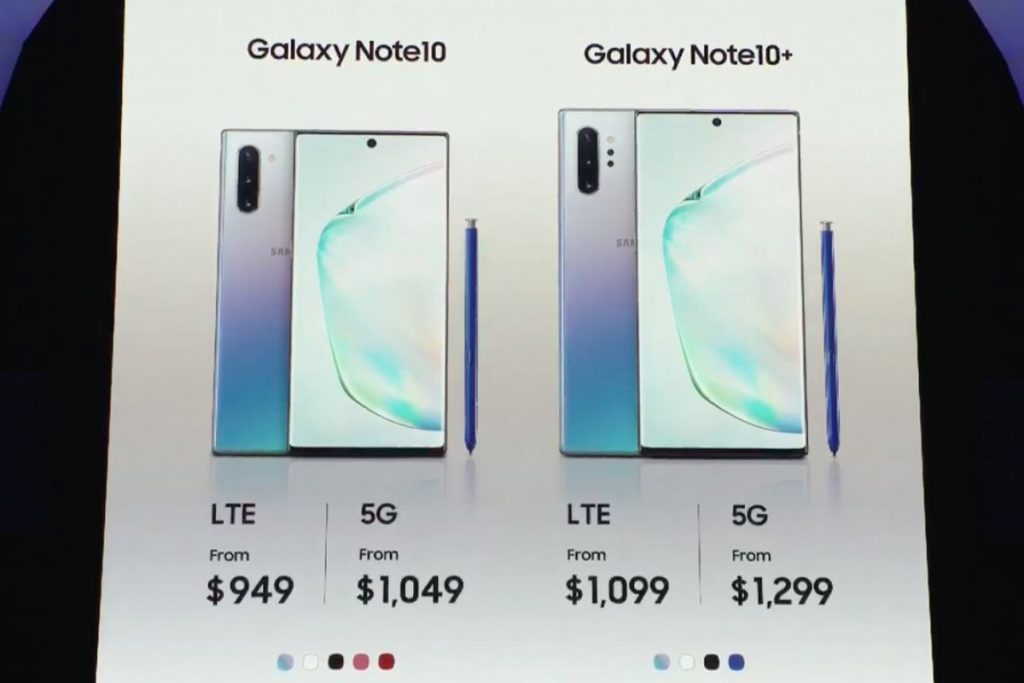
At a packed event in downtown Brooklyn at Barclays Centre, Samsung officially unveiled the Galaxy Note10 and Note10+. As leaks, rumors, and the Seoul tech giant’s own marketing materials foretold, the twin flagships leapfrog the Note9 in most — if not all — respects. Among the highlights are an in-screen fingerprint sensor, fast-charging large batteries, a speedy processor, and Samsung’s signature S Pen enhanced with gesture recognition. And those are just the tip of the iceberg.
The Galaxy Note10 series will be available for pre-purchase starting August 8 at 12:01 am ET, with orders expected to ship by August 23 for those who reserved a spot in the preorder line. Here’s what you need to know.

Design
Samsung switched things up this year with two Note models instead of one: the Note10 and Note10+. Neither diverges much from the series’ established formula, but a few nips and tucks bring them in line with current trends.
The Note10’s and Note10+’s frames are made from scratch-resistant aluminum that’s IP68 rated to withstand 1.5 meters of water for 30 minutes, and their protective glass shielding — Corning’s Gorilla Glass 6, an upgrade from the Note9’s Gorilla Glass 5 — can withstand up to 15 consecutive drops from 1 meter onto rough surfaces.
The Note10 and Note10+ weigh about 168 grams and 198 grams, respectively, or lighter than the 201-gram Note9. And the phones’ bezels are narrower than those of the Note9, with the most dramatic gains coming from the right, left, and top. But perhaps the most obvious difference between the old and new models is the roughly 6-millimeter hole-shaped cutout top of center, which accommodates the front-facing camera. Samsung calls the design “Infinity-O,” and it debuted on the midrange Galaxy A8 series phones before graduating to the Galaxy S10 series in February.
Taking another cue from the S10 lineup, Samsung did away with the iris scanner, a hallmark of Note phones since 2016. (An ambient light sensor and earpiece speaker take its place.) And in yet another series first, the Note10 and Note10+ have a Qualcomm-supplied ultrasonic fingerprint sensor embedded beneath their display glass. They work as you’d expect — placing a digit on the highlighted portion of the screen unlocks the phones — but Qualcomm’s proprietary 3D Sonic Sensor tech is one of the first to boast FIDO Alliance Biometric Component certification.
Around the back of the Note10 and Note10+, you’ll find a triple-sensor camera module and LED flash akin to that on Galaxy S10 series phones. The bottom portion houses a USB-C port and a loudspeaker (the latter of which works in tandem with the earpiece to deliver stereo sound), and on the left side, there’s a volume rocker adjacent to the power button.
What you won’t find on this year’s Note models are Bixby keys — remappable buttons on previous-generation Galaxy and Note handsets that trigger Samsung’s homegrown AI assistant by default — or 3.5mm headphone jacks. Also missing in action is the Note9’s health sensor, which measures biometrics like heart rate, blood oxygen, and blood pressure. They’ve been done away in the pursuit of minimalism, but fortunately not completely thoughtlessly — there’s a USB-C-to-3.5mm adapter in the box, and Bixby can be activated with a double-press of the power button.
Display
Here’s how the Note10 and Note10+’s display sizes and resolutions break down:
- Galaxy Note10: 6.3 inches, 2,280 by 1,080 pixels (401 PPI)
- Galaxy Note10+: 6.8 inches, 3,040 by 1,440 pixels (498 PPI)
The Galaxy Note10’s HDR10+-compatible, Dynamic AMOLED Infinity Display is a tad smaller than that of the Note9, which measures 6.3 inches diagonally — the result of the 19:9 aspect ratio (compared with the Note9’s 18.5:9). It’s also slightly blurrier, at about 401 pixels per inch (compared with the Note9’s 516 PPI) owing to a downgrade in resolution to 2,280 by 1,080 pixels (versus 2,560 by 1,440 pixels).
That aside, the Note10 and Note10+’s panels are certified by the UHD Alliance for Mobile HDR10+ (High Dynamic Range) Premium content. Without getting into the weeds, HDR videos and video games have a wider color gamut and brightness range, contributing to a picture that’s not only more accurate, but more visually pleasing. HDR10+ kicks things up a notch with dynamic metadata that treats every frame as is its own set of colors, brightness, and contrast parameters.

Cameras and speakers
Samsung’s flagships rank alongside the Google Pixel and iPhone on the photography front, and the company is looking to cement its lead with the Galaxy Note10 series. Toward that end, the Note10 and Note10+ add more sensors to what was previously a dual-camera affair, and a bunch of other upgrades besides.
- Samsung Galaxy Note: 12-megapixel (f/1.5/2.4 variable aperture with optical image stabilization, phase detection autofocus, and a 77-degree field of view), 16-megapixel ultrawide (f/2.2 aperture with a 123-degree field of view), 12-megapixel telephoto lens (f/2.1 aperture with optical image stabilization and a 45-degree field of view)
- Samsung Galaxy Note10+: 12-megapixel (f/1.5/2.4 variable aperture with optical image stabilization, phase detection autofocus, and a 77-degree field of view), 16-megapixel ultrawide (f/2.2 aperture with a 123-degree field of view), 12-megapixel telephoto lens (f/2.1 aperture with optical image stabilization and a 45-degree field of view), time-of-flight DepthVision Camera
The Note10 phones’ cameras feature the same variable aperture tech found in the S10 series: A tiny contracting and expanding motor affords photogs the freedom to switch between f/1.5, a lower aperture better suited to dim lighting, and f/2.4, the default setting.
Hardware is nothing without great software to take advantage, and the Note10 series appears to have it. The camera app’s Automatic mode flips to the f/1.5 aperture automatically when the ambient lighting dips below a certain level, and an AI-powered scene detection feature — Scene Optimizer — tweaks color settings like contrast and white balance and enables HDR based on the landscapes, people, animals, and objects in-frame. It’ll recommend switching to the ultrawide angle lens when appropriate, as well as to modes fine-tuned for food photos, selfies, panoramas, and more. And as with the Note9, the Note10 series boosts image crispness by capturing a multi-image burst shot, dividing it into sets, and generating a composite picture.
In addition, there’s Best Shot, which snaps a photo automatically when the Galaxy S10 detects it’s properly lined up, and a multi-capture feature that lets you take photos using multiple sensors simultaneously. A bevy of bokeh effects are on tap in Artistic Live Focus, including Color Point (which turns the background black and white), Mono (which makes the entire picture black and white), and Side Light (which adds a virtual light source off-camera). AR Emoji have been enhanced, and there’s Bright Night, a take on Google’s Night Sight and Huawei’s Night Mode that combines multiple shots together to improve the quality of pictures taken in “very dark” conditions.
Oh, and there’s a new augmented reality feature that lets you create your own shareable doodle.
Both Note10 handsets have a 10-megapixel front-facing shooter with a f/1.9 aperture and an 80-degree field of view — a step up from the Note9’s 8-megapixel selfie camera but a sensor short of the Galaxy S10+’s dual front cameras. Time will tell whether it makes a tangible difference.
On the video front, the Note10 and Note10+ can record clips at up to 4K and optionally in HDR10+ (with 10-bit color), though you’ll need an HDR-compatible display to appreciate the latter fully. A nifty new tool — Audio Zoom — taps three separate mics to emphasize audio from whatever you’re focused on, while video bokeh blurs out the background while focusing on the foreground. As for Super Slow-Mo, it shoots clips at a blistering 960 frames per second for between 0.4 and 0.8 seconds at up to 1080p, or double the 0.2-to-0.4-second duration and 720p resolution limits in the Galaxy Note9.
In cases where you need a shot steadier than what the optical image stabilization can provide alone, there’s Super Steady, which launched with the S10 series. Samsung describes it as a “professional-level” setting that can hold its own against action cams like GoPro’s Hero 7.
AKG
The Note10 and Note10+ play stereo sound through the earpiece and a bottom-firing loudspeaker. They’re both tuned by AKG Acoustics and support the Direct Stream Digital (DSD) format (64/128) and Dolby’s Atmos 3D simulated surround sound technology in supported apps.

Bluetooth S Pen
The Note10 series ships with Samsung’s S Pen, which has 4,096 pressure levels and packs a Bluetooth modem. It pairs to the phones to unlock them, and it advances through slideshows, activates the camera shutter or switches between lenses, controls music playback, and even stands in as a six-axis game controller.
New this year is a gestures feature — Air Actions — that lets you squiggle shapes above the phone’s screen to launch apps and adjust settings. Samsung partnered with Spotify and YouTube to build in gesture support for their respective Android apps. And starting today, developers can download a software development kit to build gesture-supported apps of their own.
The S Pen otherwise supports the range of Note features users have come to know, like Live Drawings, which allows you to sketch or write messages on photos and backgrounds and send them as GIFs to anyone in your contact list. Beefed-up handwriting tools let you convert handwritten messages to digital text (and shrink, enlarge, or change the color of the text) and export them in a range of formats, including Microsoft Word .doc files. Also present and accounted for is Screen-off Memo, a digital sketchpad that lets you scribble notes on the Galaxy Note10’s always-on screen without having to unlock it first.
Rounding out the Note10’s S Pen tools are Translate, which automatically translates words and phrases as you hover over them with the S Pen’s tip; Magnify, which enlarges parts of the screen; and Smart Select, which lets you crop out a portion of the Note9’s screen and save it as a snapshot.

Processor
Pop open the hood of the Note10 and Note10+ and you’ll find one of two system-on-chips: Samsung’s Exynos 9825 or Qualcomm’s Snapdragon 855. Samsung demoed the Exynos 9825 variants at today’s event, but some territories — likely North America, Latin America, Hong Kong, China, and Japan — will get a Snapdragon-based model.
Exynos 9825
Samsung quietly announced its latest octa-core chipset ahead of today’s Note10 festivities, and it’s a doozy. The Exynos 9825 — the successor to the Exynos 9820 — is the industry’s first built with a 7-nanometer extreme ultraviolet lithography processing technology, which Samsung claims enabled the printing of finer circuits than was previously possible. It features a “tri-cluster” architecture consisting of two Cortex-A75 cores for high-performance workloads and four Cortex-A55 cores for less intensive tasks, and it’s equipped with the Mali-G76 MP12 graphics chip, which runs at faster clock speeds compared with previous generations.
The Exynos 9825 packs a neural processing unit (NPU) for on-device artificial intelligence (AI) applications, making it the second Samsung chipset with a dedicated AI chip after the Exynos 9820 (following in the footsteps of Huawei’s Kirin NPU and Apple’s neural engine). It accelerates on-device inferencing tasks such as object recognition in photos and faster app pre-loading, and the benefits extend to the Note10’s and Note10+’s cameras. According to Samsung, the NPU can detect and identify a range of objects and scenes which the image signal processor (ISP) then retouches.
Finally, like the Exynos 9820 before it, the Exynos 9825 has a physically unclonable function (PUF) that stores and manages personal and biometric data (such as facial and biometric scans) in isolation. The PUF provides a unique key while a separate component — the secure key manager — supports other security protocols, such as key generation and derivation.
Qualcomm Snapdragon 855
As for Qualcomm’s Snapdragon 855, it’s a 7-nanometer eight-core chip that, like the Exynos 9820, can achieve up to 2Gbps cellular speeds courtesy the embedded X24 LTE modem. It supports Wi-Fi 6 (aka 802.11ax) along with 802.11ac Wave 2 for superior performance on pre-802.11ax networks, and it’s up to 45% faster overall thanks to a 64-bit ARM Cortex design based on Qualcomm’s in-house Kryo 485 processor.
Four cores handle the heavy lifting — one prime core clocked at 2.84GHz and three performance cores at 2.42GHz — while four efficiency cores running at 1.8GHz handle less performance-intensive tasks. Unlike the Exynos 9820, the Snapdragon 855 diffuses AI capabilities across multiple processing components (including a new tensor accelerator called Hexagon 690) for a total theoretical capacity of seven trillion operations per second. Qualcomm is claiming an AI performance improvement of three times compared to its previous flagship chipset, the Snapdragon 845.
Meanwhile, the Snapdragon 855’s graphics chip — the Adreno 640 — is 20% faster than the Snapdragon 845’s Adreno 630, and it supports HDR (along with APIs like Vulkan 1.1) and custom algorithms designed to reduce dropped frames by over 90%. Additionally, it enables developers to use physically based rendering (PBR) to replicate the way light reflects off of real-world materials.
Last but not least, the Snapdragon 855 features a redesigned camera pipeline that moves computer vision features directly into the ISP. Dual 14-bit CV-ISPs are packed into the Spectra 380, each with hardware-based depth sensing that allows for video capture, object classification, and object segmentation in real time.

Battery life, memory, storage, and connectivity
So clearly the Galaxy Note10 series packs a processing punch, but what about the battery life? That depends on the model. Fortunately, both the Note10 and Note10+ should charge substantially faster than the Note9, if Samsung’s marketing is to be believed.
They’re the first to ship with Samsung’s Superfast Charge, which gives “hours” of juice in just a few minutes of 45W fast charging (though they ship with a 25W charger). Both wirelessly charge when they’re set atop Qi chargers — the Note10 up to 12W and the Note10+ up to 20W. Separately, PowerShare, which lets you use the Note10 or Note10+ to recharge Qi accessories wire-free by placing them on the flat portion of the phones’ rear covers (below the camera), has been improved — it now delivers up to 15W.
Both Snapdragon and Exynos Note10 variants benefit from hardware acceleration for H.265 and VP9 codecs, which improves power efficiency and reduces power consumption during video recording. And they boast Samsung’s Adaptive Power Saving tech, which optimizes battery performance based on app usage.
Here are the battery capacities of each phone:
- Galaxy Note10: 3,500mAh (down from the Note9’s 4,000mAh)
- Galaxy Note10+: 4,300mAh
And here’s their RAM and storage capacities. Note the absence of removable storage on the Note10:
- Galaxy Note10: 8GB LPDDR4x RAM (up to 12GB in Korea only), 256GB (UFS 3.0) storage
- Galaxy Note10+: 8GB LPDDR4x RAM, 256GB/512GB (UFS 3.0) storage (expandable via microSD card)
Wireless
On the connectivity side of the equation, the Note10 series supports the standards you’d expect in flagship 2019 smartphones, namely Wi-Fi 802.11 a/b/g/n/ac/ax (Wi-Fi 6) and Bluetooth 5.0. Intelligent Wi-Fi, a new battery-saving feature, jumps between LTE and wireless with the help of AI that recognizes when the phone’s in an enclosed location and when it’s on the move (like when you’re in a car or walking down the street).
On the cellular side of the equation, Samsung’s Exynos 9825 packs an LTE-Advanced Pro modem that supports LTE Category 20, offering downlink speeds of up to 2.0Gbps with 8 times carrier aggregation (CA) and an uplink speed of up to 316Mbps. That downlink speed is up from 9810’s maximum of 1.2Gbps, and it comes thanks in part to accouterments like 4×4 Multiple-Input, Multiple-Output (MIMO), 256-QAM (Quadrature Amplitude Modulation), and Enhanced Licensed-Assisted Access (eLAA) technology.
The Note10+ comes in a 5G-compatible flavor, but it predictably costs more than its LTE counterparts. Like the recently released Samsung Galaxy S10 5G, it supports sub-6GHz bands and millimeter wave, the backbone technologies of today’s cellular 5G networks.
Software
OneUI
Like phones in the Galaxy S10 series, the Galaxy Note10 and Note10+ run One UI, Samsung’s overlay atop Android Pie. In addition to font tweaks and redesigned navigation buttons, the UI is much more intuitive than previous versions of the company’s mobile flows, not to mention more responsive.
The upper portion of the screen is reserved for viewable content, while the lower portion is devoted to interactions. Focus Blocks — bright, colorful buttons that stand out against dark backgrounds — make clear just which elements are interactive. As for pop-ups, which previously appeared near the middle of the screen, they now populate the bottom where they’re easier to reach.
In other improvements, the One UI settings menu groups related functions together, and it’s been reordered so that the most important options appear first, near the top. The dialer app’s UI is dynamic — when you’re dialing a number, the display changes accordingly, concealing the search bar and menu tabs. And in the clock app, it’s easier to switch between tabs devoted to functions like stopwatch and timer.
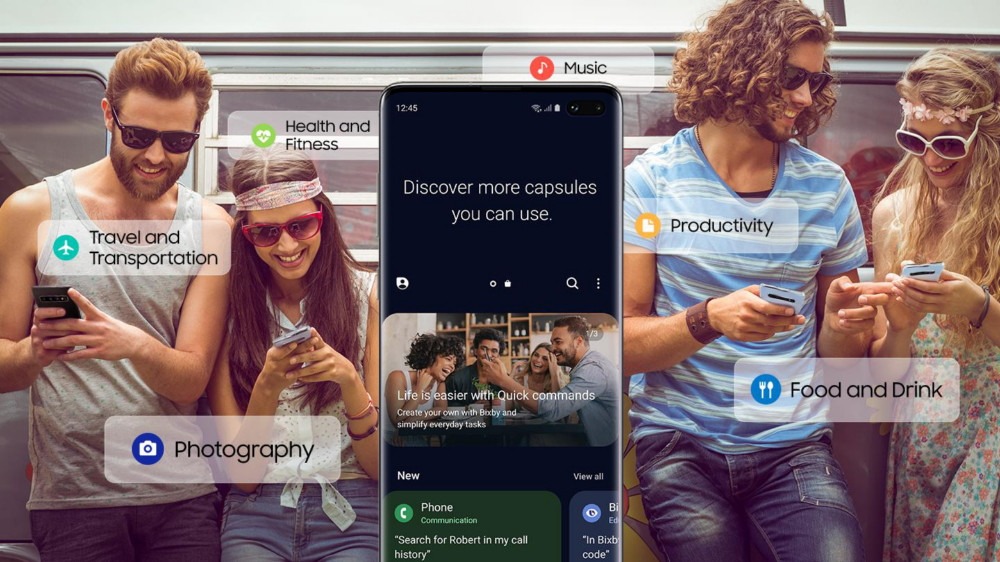
Bixby
One UI isn’t the Note10 series’ only spotlight software feature.
In July, Samsung launched the Bixby Marketplace in the U.S. and South Korea, a dedicated app store where third-party developers can offer their own Bixby-compatible services, similar to Amazon’s Alexa skills. Through it, users can search for services — which Samsung calls “capsules” — that enhance Bixby. Capsules can be added with a tap, and the Bixby Marketplace supports ratings and reviews to help surface the best, or most popular, capsules.
Also on tap is Bixby Home, a “social stream for your device.” It’s a dashboard of reminders and social media updates collated in cards that can be dismissed, pinned, or permanently hidden.
Bixby Vision — which taps computer vision to recognize and classify objects in photos, much like Google’s Google Lens and Amazon’s Flow — natively supports document scanning. Thanks to integrations with Vivino, Amazon, Nordstrom, Sephora, Cover Girl, and others (and Samsung’s data-sharing partnerships with FourSquare and Pinterest), it can scan barcodes and show relevant product listings, recommend wine, display the calorie counts of food, and let you virtually “try on” makeup products.
As for Bixby Voice, Samsung’s answer to Amazon’s Alexa and Google Assistant, it works just as it does on the Note9 — say “Hey, Bixby” or hold down the Bixby key to prime it for commands like “What’s the weather forecast?” and “Call John.” More than 3,000 commands in six languages (English, Korean, Chinese, Spanish, German, French, Italian, and Spanish) are supported in all, including chained ones like “Open the gallery app in split-screen view and rotate misaligned photos” and “Play videos on a nearby TV.”
Bixby, like any modern voice assistant, recognizes requests to add items to your calendar, queue up tunes, place calls, and launch apps, and it can answer basic questions about sports scores, movie showtimes, business hours, and more. It’s also somewhat conversational. When you ask it about upcoming concerts around New Year’s, for example, it’ll remember the date range when looking for tickets in the future.
A relatively new addition to Bixby is Bixby Routines, which rolled out earlier this year. Much like Alexa Routines and routines on the Google Assistant, Bixby offers preset and personalized routines, such as Driving and Before Bed routines, which can be customized based on your habits.
DeX
There’s good news on the DeX front: As with DeX on the Note9, it doesn’t require a dock — Samsung calls this Dex Lite. All you need is a USB Type-C-to-HDMI adapter; connecting it to an external display gets DeX up and running in a jiffy.
DeX mode displays a Windows-like interface, replete with resizeable windows, a dedicated taskbar, mouse and keyboard support, and shortcuts to files, the photo gallery, and settings. Samsung teamed up with Microsoft to optimize Office apps (Word, PowerPoint, and Excel) for the interface, and with Epic Games to support Fortnite. Other partners include the New York Times, Deezer, Amazon, TripAdvisor, Citrix, VMWare, and Craigslist.
New this year are apps for both Mac and Windows. In practice, that means you’re able to plug the Note10 or Note10+ directly into a PC to get a window with your phone apps in it. The Galaxy Note10 series is compatible with Microsoft’s “Your Phone” feature from Windows 10, and it’s activated with a Link to Windows shortcut in the Quick Settings panel. Gamers can use their Samsung account to stream games from a laptop or desktop and play them on the Note10, via Play Galaxy Link. And later this year, you’ll be able to make and receive calls from a linked Windows PC.
Smartphone apps run in DeX, but Samsung makes no guarantees that they won’t misbehave.
Pricing and availability
Here’s a breakdown of pricing:
- Galaxy Note10: $950 (256GB)
- Galaxy Note10+: $1,100 (256GB) or $1,200 (512GB)
- Galaxy Note10+ 5G: $1,300 (256GB) or $1,400 (512GB)
The Note10 series is available in auro glow, auro white, and auro black at launch, with region-specific colorways to come later this year.
In the U.S., the Galaxy Note 10 Plus 5G is a timed exclusive on Verizon. It’ll come to AT&T, Sprint and T-Mobile later in the year.


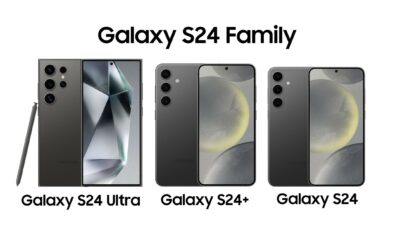

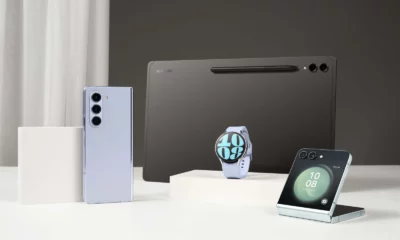

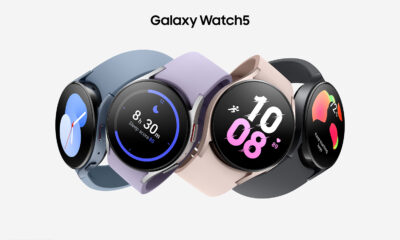

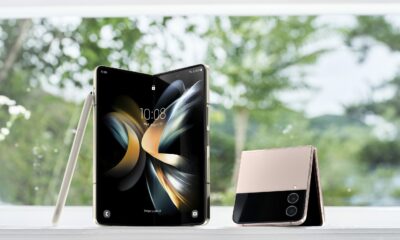
















Recent Comments